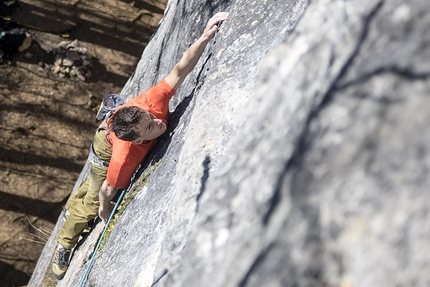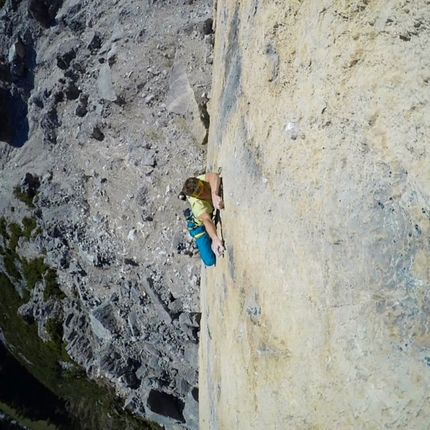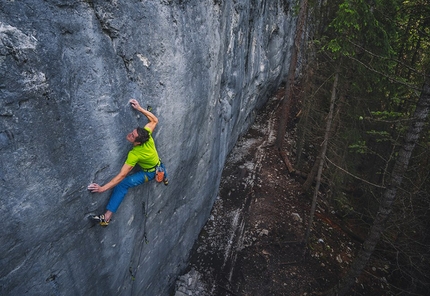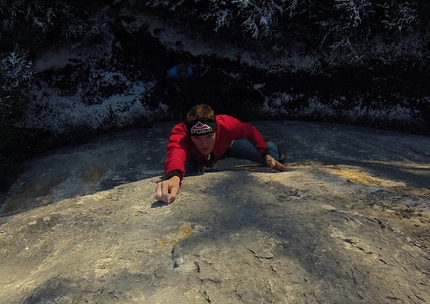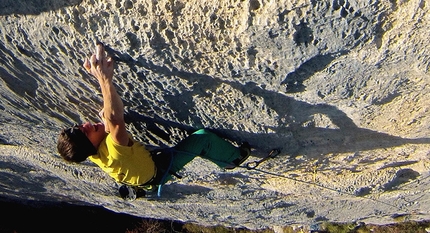Alessandro Zeni, the 9b Saint Loup Cryptography interview
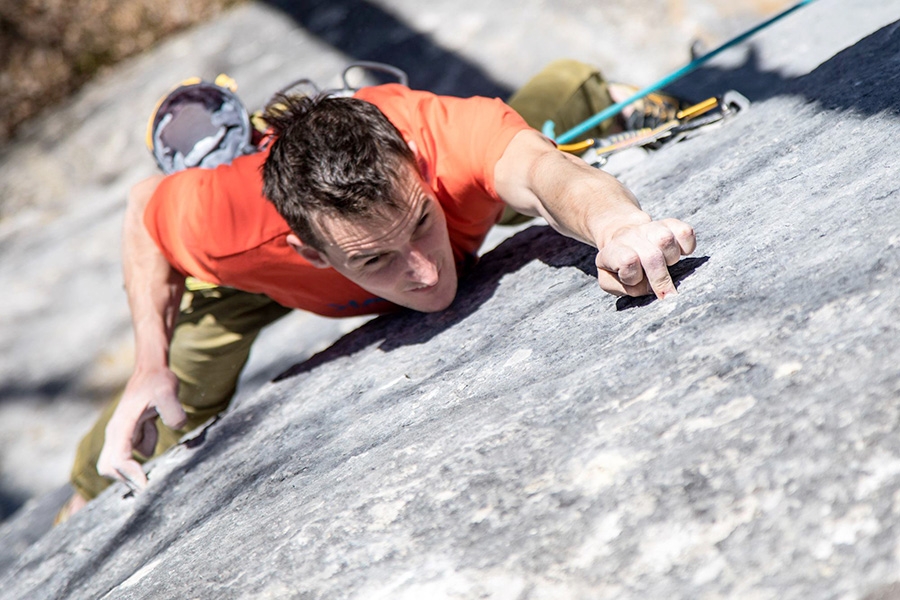
 1 / 5
1 / 5 Stefano Jeantet
Stefano Jeantet
Let's get straight to the point: three days ago the news broke that on 11 January 2020 Alessandro Zeni made the first ascent of Cryptography, the connection of the two famous slabs Bain de Sang and Bimbaluna, established by Fred Nicole and François Nicole respectively at Saint Loup in Switzerland. For this connection the 28-year-old Italian has put forward the grade 9b, indicating that it might well be one of the hardest slab climbs in the world. On a par with another heinous slab, Disbelief at Acephale in Canada, freed by Adam Ondra in 2018. Here’s the interview.
Let's start from the beginning, from Bain de Sang. First ascended in 1993 by Fred Nicole, one of the first 9a’s in the world, the world’s first female 9a and a style of climbing that suits you perfectly…
It’s incredible to think that these routes were put up so long ago, by Fred and François Nicole, two absolute pioneers, undeniable artists and great climbers! It’s no coincidence that I chose Bain de Sang as my first 9a. A historic slab, the first female 9a at the hands of Josune Bereziartu in 2002… all the right ingredients to let my imagination travel.
This climb encloses the climbing history of an entire generation, it’s a way of interpreting rock climbing that is considerably different from what’s fashionable nowadays. It’s a line that from below seems almost easy because it’s perfectly vertical, but as soon as you lift your feet off the ground you immediately realise how insidious it is.
I have to admit that on my first trip to Saint Loup with Riccardo Scarian, Sky, in 2015 I didn’t understand very much... It took another two years before I gained the necessary experience to climb a route like this one. Then in January 2017 I immediately noticed that something had changed, and that I was finally capable of holding crimps I’d originally considered to be nothing more than footholds! Redpointing Bain de Sang proved to be an important stepping stone for all my future climbs, both at the crag and in the mountains.
In late 2017 you returned to Saint Loup to try its monumental neighbour, Bimbaluna put up by François Nicole
Yes, Sky and I returned to Saint Loup in December. He’d already sent Bain de Sang in 2006 and now we wanted to test ourselves on Bimbaluna. Having seen Sky’s attempts during the previous years I knew that Bimbaluna is completely different than Bain de Sang, with difficulties concentrated in a 6-move boulder problem which warrants FB 8B/+. On my first attempts I immediately felt good on its extremely small and sharp edges and with the Sky’s precious advice I actually managed to repeat it very quickly indeed, almost unexpectedly.
It was then that you realised you hadn’t reached your limit, and that you started dreaming about something “crazy,” right?
This is why life is so beautiful. You set yourself a goal and when you finally achieve it, you raise the bar a little higher. We all know we won’t be able to improve indefinitely, but the great thing is trying to test your limits always, regardless of age or the actual technical difficulty. At the moment this gives me immense joy, , in forty years time I’ll probably be just as happy if I manage to repeat a route I now do as a warm-up. Life is all about seasons, what is certain is that I’ll always give my absolute best as long as I’m strong enough to do so. It’s precisely this quest for something new that prompted me to try this connection that I initially thought was well beyond my reach.
So how crazy was this idea of linking the two routes?
I started trying it right after redpointing Bimbaluna and immediately realised that it was’t the individual moves that made this climb so difficult, but the fact that you need really strong fingers for the Bimbaluna crux after the first section of Bain de Sang. After that first attempt I realised that I’d need to be strong enough to do the boulder crux easily if I wanted to send the entire route. More easily said than done! It took almost two years to build that necessary strength!
Basically it’s the crux of Bain linked to the crux of Bimba, right?
Yes, the link joins the cruxes of both routes. The difficulty of Cryptography lies in the fact that as you traverse from left to right, you avoid the huge rest in the middle of Bain de Sang. The moves across aren’t that easy either, with a long reach right to a monodoigt that leads straight into the Bimbaluna crux. The first part of Bain de Sang was graded 8b/c by Fred Nicole, the bouldery traverse gets about FB 7B I’d say, and this is followed by the Bimbaluna’s bouldery finish. All without a real rest in the middle of the climb.
On both Bain de Sang and Bimba Luna there are rests that allow you to recover before dealing with the crux, but these rests are avoided on Cryptography. I think that’s what makes it so difficult. And then of course there’s the fact that it’s almost impossible to chalk up except on some moves, to which you need to add that the holds are so small and sharp that you can never give it more than just a few attempts per day.
You mentioned two years of training. How did you prepare for this climb?
I did a lot of fingerboard training, which essential to increase specific finger strength, and I combined this with system training and campus boarding. But his was only the training at home. What was fundamental was transforming this strength and trying really hard routes outside, and my main testing ground was the crag Bilico, up in Val Canali.
How important is pure power on a slab like this?
Although it’s a slab, it would be wrong to think that physical strength isn’t necessary and that it all boils down to good footwork. The first section of Bain de Sang in particular, with it’s big shoulder presses, is extremely physical despite being a slab! There are many key factors: finger strength, being able to climb well, self-control, being able to dose your energy by finding the right balance and, last but not least… luck! If conditions aren’t right a slab, far more than a steep overhang, simply won’t let you climb it, and it’s almost impossible to compensate for poor conditions with physical strength and training.
How many attempts and journeys did you need prior tu success?
On each trip we spent about 5 days in Saint Loup, I don’t know exactly how many trips we did but since 2017 I reckon about 12 in total, to climb Bain de Sang, Bimbaluna and Cryptography. The thing that was really amazing is that our motivation never flagged. This can’t be taken for granted, especially on routes like this when sometimes you fall just a hair’s breath away from success, as Sky did in 2017 on Bimba Luna!
If we’re not mistaken, you gave the climb its name before you freed it, right?
Yes, I gave it a name even before I was strong enough to do it, because I thought that this might motivate others to give it a go if I failed (in the beginning I didn't really believe I’d stand much of a chance). I thought this line was really worth completing, if not by myself, then by someone better than me.
So tell us about that 11th of January? How did things go?
I knew I was ready but I didn't expect it to go down so quickly! I’d just recovered from a finger injury, and for this I really have to thank my girlfriend Ilenia who, as a great physiotherapist, managed to fix me in record breaking time with a nice series of Tecar therapy sessions. I got an indication about my form in early January when I visited Cornalba for the first time and sent C'era una volta in America, the historical 8c, in just 3 attempts. I narrowly missed the redpoint on my second attempt due to a silly mistake, while the redpoint almost felt like a walk in the park. I realised that this was going to be a good year for my Switzerland project, and it was!
On 11 January conditions were excellent, and I was on great form physically and mentally. It was one of those no gravity days, when a route doesn’t seem difficult at all and you even question why it was so hard. But then when you think about how much you had to put into it to join all the pieces of the jigsaw puzzle, then you convince yourself that it can’t be that easy after all.
In many ways that’s the beauty of slab climbing. You spend a lot of time and energy to decipher a single move that, in the beginning, seems absolutely extreme. But then on the day of the send everything flows fluidly and quickly, so simply that you’re tempted to believe it’s almost too easy. That’s why on my return from Switzerland I immediately went to try a climb I’d attempted many years ago, Stramonio 8c/+ put up by Manolo, which I managed to repeat that day on my third attempt. This gave me further confirmation that I was on amazing form.
You mentioned earlier that you were searching for your limit. How close did you get that day?
On the redpoint I didn't really feel as if I was at my limit, because I had assimilated the moves so well that they were almost completely automatic.. My body knew exactly how to move in order to save precious energy, my feet knew how much they could push on those tiny footholds and my fingers how much they could pull those holds, to avoid wasting energy and trashing my skin before reaching the crux.
You’ve put forward the grade 9b, almost at the absolute apex. Why d’you reckon it’s 9b and how does it you compare to other routes of this style you’ve climbed before?
Giving a grade to Cryptography was a difficult process. It’s always difficult to stick your neck out, especially when the grade is at the limit of this style of climbing which has few comparisons simply because there are few other reference routes. But I reckon it’s a mistake not to give a route a grade out of fear of exposing oneself. The only thing you can do is be as honest as possible with yourself and with others, having searched for comparisons which are as similar to the climb in question as possible.
I actually struggled to convince myself that Cryptography could be this difficult, but ultimately I couldn’t help but base my decision on the grades given to the other two routes, Bain de sang which is given 9a and Bimba luna, graded 9a/+. Both have been repeated and the grades confirmed by climbers who I believe have a lot of experience on this type of climbing.
Even if Bain de Sang were to be rated 8c+, Cryptography remains a grade and a half harder That’s why I graded Cryptography 9b, it couldn’t have done otherwise. If it’s not, then both Bain de Sang and Bimba Luna would need regrading. But as usual this is only a preliminary suggestion, while waiting for those who wish to repeat this beautiful route. You know, more than the grade itself, it represents the history of two great slab climbers, Fred and François Nicole.
Over the years you’ve specialised at slab climbing. How come? What do slabs give you that overhangs don’t?
My evolution towards slabs was fairly natural, initially tied to the fact that here in the Primiero region of the Dolomites are crags are mainly vertical and extremely technical. As time wore on I realised that this terrain really did give me both the freedom and the excitement I’ve always been looking for. The challenge of searching for the smallest hold, for the perfect balance, is something that really fascinates me.
I’ve also been really lucky to have been able to share a rope with many really good climbers, such as Enrico Bettega, Yuri Gadenz, Manolo and above all Riccardo Scarian, the person who most of all has made me appreciate this beautiful dimension of the upper extreme on slabs.
I perform far better on slabs than on overhangs, partly because I’ve never really spent much time upside down, and also because of my physical limits that have led me to redpoint overhanging climbs up to 8c+.
The beauty of climbing lies in its freedom of expression and although I really admire those who manage to send really difficult overhanging routes, I’m happy with my physical and technical capabilities I’ve acquired through years of training, and personally I wouldn’t really want to swap it for anything else.
If you want to: how come you waited so long to share the news about your first ascent?
Well it was dictated mainly by the fact that in January I had the great fortune of starting a new sponsorship with the company that has always worked closely with my home mountains: Karpos. At the time the decision to publish this news would somehow have overshadowed the other. So we decided for the Karpos sponsorship news first so as to to take photos and make a video about Cryptography in order to give it the visibility it deserves. Then with the problems related to Covid-19 things took a little longer…
So it’s been several months since the first ascent. Knowing you, you’ve already got some new projects in mind.
Right now I am trying to establish a new multi-pitch climb together with my friend Sky, the difficulties will be pretty high. Without wishing to diminish sport climbing at the crag in the slightest, for me personally my ultimate goal is taking these difficulties into the mountains, and using bolts sparsely in favour of long run-outs. Everything feels more adventurous and complex up in the mountains, the views are breathtaking and the hundreds of meters of void exalt me and really make me feel alive. The days spent forging a line a true tests of self-control and risk analysis, where success is anything but certain.
I’ve also got lots of other projects in mind with my colleagues from the High Mountain Military Corps: climbing big routes from the Dolomites to Mont Blanc and in Val di Mello. And with my friend Andrea Cattarossi I’d like to do some routes on Marmolada, Civetta and Cima Scotoni. But everything depends on how this difficult moment evolves here in Italy, although I like to believe that things will soon return to a new normal.
Alessandro thanks C.S. Esercito and his sponsors: Karpos, La Sportiva, Grivel



 Copia link
Copia link

